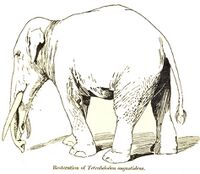
FAIR is a non-profit organization dedicated to providing well-documented answers to criticisms of the doctrine, practice, and history of The Church of Jesus Christ of Latter-day Saints.
(m) |
|||
| Line 41: | Line 41: | ||
{{Articles Footer 1}} {{Articles Footer 2}} {{Articles Footer 3}} {{Articles Footer 4}} {{Articles Footer 5}} {{Articles Footer 6}} {{Articles Footer 7}} {{Articles Footer 8}} {{Articles Footer 9}} {{Articles Footer 10}} | {{Articles Footer 1}} {{Articles Footer 2}} {{Articles Footer 3}} {{Articles Footer 4}} {{Articles Footer 5}} {{Articles Footer 6}} {{Articles Footer 7}} {{Articles Footer 8}} {{Articles Footer 9}} {{Articles Footer 10}} | ||
[[es:El Libro de Mormón/Anacronismos/Animales/Elefantes]] | |||
To see citations to the critical sources for these claims, [[../CriticalSources|click here]]

A lesser-known type of elephant-like creature also existed from 12 million years ago until around A.D. 400. These were the Gomphotheres:
In short, the elephant presents no problem for the Book of Mormon.
<videoflash>BgzVaU6F1e4</videoflash>
==

FAIR is a non-profit organization dedicated to providing well-documented answers to criticisms of the doctrine, practice, and history of The Church of Jesus Christ of Latter-day Saints.
We are a volunteer organization. We invite you to give back.
Donate Now